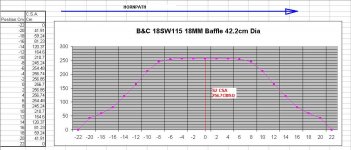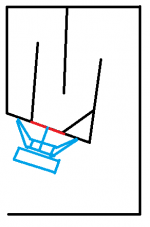Agreed, and measurements trump sims, however later in post 129 Art mentions his measurement gear being off which brings the low corner closer to the sim. For some odd reason I always remember that.
(snip)
"The RTA 420 mic response rolls off slightly below 60 Hz, about 1 dB down at 40 Hz, 2dB down at 30Hz, 4 dB down at 16 Hz. That falling response curve makes the Keystone measurements look a little more upward tilted than the actual response is."
Enough with the conjecture... OP is just gonna have to build it and report back! 😀
(snip)
"The RTA 420 mic response rolls off slightly below 60 Hz, about 1 dB down at 40 Hz, 2dB down at 30Hz, 4 dB down at 16 Hz. That falling response curve makes the Keystone measurements look a little more upward tilted than the actual response is."
Enough with the conjecture... OP is just gonna have to build it and report back! 😀
So... there's absolutely no objective evidence that "cone correction" does anything at all?
This isn't a surprise, since theory and simulation say it's nonsense, but I was expecting to see something from the people that have been talking about it over the last couple of years like it's the best thing since sliced bread.
Here is the little bit of data that I have. Note that the correction plate was not by any means perfect and was inadequately secured. Due to the odd angle half way through the throat area under the driver in the original version of the Othorn it was not sitting flat on the panel opposite the driver and the 4dry wall screws I used for a quick and dirty method of attachment were not enough. I also did not do a whole lot of verification of clearances from the cone.
You can see that it did improve the flatness of the response and overall sensitivity a bit above 75Hz but that it did almost nothing below 75Hz. I do consider it an improvement in response with the plate but something happened when zapping the Othorn with a bridged K10 and test signals and a bad noise was heard. I do not know whether the pressure on the driver was too much, the excursion clearances were not enough, or the pressure inside the throat vibrated the plate hard enough to break it loose and then it made contact. Either way I ended up with a damaged cone. I glued the cone with rubberized CA glue to repair it and removed the plate and it then survived the test signals and many subsequent beatings with no issue. I meant to put a lot more effort into the correction plate and do it "right" and test again but since the effect with it in the cab was so small and mostly above 75Hz and the cabs are generally high passed below 80 or 90Hz anyway I got lazy and never did it. I still don't have a correction plate in the Othorn or the plans even though I've had it accurately measured and designed for awhile.
That's all I got. I haven't seen any actual measurements from anyone else on this subject yet.
The measurements are taken ground-plane at 1m at either 1.86v or 18.6v. (Back when I was doing calculated 1w into min impedance for sensitivity)There is no processing on the signal. Also note that there is no smoothing on these measurements. 😉 Also note that the second measurements set has 2 measurements with varying degrees of dampening added to the cabinet. Both reduced sensitivity and output noticeably and really didn't do much in the time domain to justify it so I removed dampening from my Othorns and never used it or recommended it.
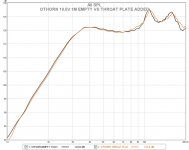
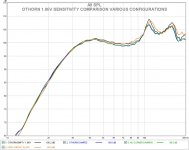
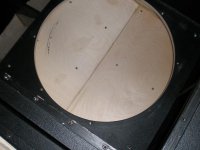
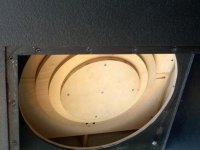
Last edited:
Hi Sine143!
"PASC did note "better cone control" with the keystone. if this give the keystone 2db more powerhandling (better excursion control)... that would explain the extra output"
Both cabs with 18NLW9600 Eighteen Sound. Pink noise with amp capable 2300W clean (no that ms thing). Also with WAV music.
KS LR24 20 ~ 200Hz OK with good cone control near flat. DSP8000 - ECM8000 not calibrated (so you know it decays below 40Hz);
Image - TinyPic - Free Image Hosting, Photo Sharing & Video Hosting
Image - TinyPic - Free Image Hosting, Photo Sharing & Video Hosting
TH18 LR24 38 ~ 96 Hz with large excursion. Put lower than 38Hz lowcut at your risk.
Also tried in the TH18 the 18TBX100 and 18LW2400, but no more than 1200W with 18TBX100,and 1000W with 18LW2400 to make the cones dance(travel) a lot; result are like equal for these two drivers, so advantage to the 18LW2400 which costs less.
TH was made full of braces and corner reflectors, also filled it and KS with sawdust mixed with glue to avoid leaks at all corners, but not added at the time of the building, with cone correction apparatus.
Cone correction added to 6 SS15 boxes, and work at mouth to fix it from any vibrations proved to me, that also the lows missed before (40/50Hz), and now clear bass guitar notes from 80 to 100Hz playing thru it.
The reward for this work was a noticeable less cone travel and around + 2 dBs, using it LR 38 ~ 96 and or 100Hz band.
So, maybe work it into TH18 is worth.
Regards,
"PASC did note "better cone control" with the keystone. if this give the keystone 2db more powerhandling (better excursion control)... that would explain the extra output"
Both cabs with 18NLW9600 Eighteen Sound. Pink noise with amp capable 2300W clean (no that ms thing). Also with WAV music.
KS LR24 20 ~ 200Hz OK with good cone control near flat. DSP8000 - ECM8000 not calibrated (so you know it decays below 40Hz);
Image - TinyPic - Free Image Hosting, Photo Sharing & Video Hosting
Image - TinyPic - Free Image Hosting, Photo Sharing & Video Hosting
TH18 LR24 38 ~ 96 Hz with large excursion. Put lower than 38Hz lowcut at your risk.
Also tried in the TH18 the 18TBX100 and 18LW2400, but no more than 1200W with 18TBX100,and 1000W with 18LW2400 to make the cones dance(travel) a lot; result are like equal for these two drivers, so advantage to the 18LW2400 which costs less.
TH was made full of braces and corner reflectors, also filled it and KS with sawdust mixed with glue to avoid leaks at all corners, but not added at the time of the building, with cone correction apparatus.
Cone correction added to 6 SS15 boxes, and work at mouth to fix it from any vibrations proved to me, that also the lows missed before (40/50Hz), and now clear bass guitar notes from 80 to 100Hz playing thru it.
The reward for this work was a noticeable less cone travel and around + 2 dBs, using it LR 38 ~ 96 and or 100Hz band.
So, maybe work it into TH18 is worth.
Regards,
Last edited:
Here is the little bit of data that I have.
Thanks.
Without simulating (I don't have time right now) this is about what you would expect - a very small change and really no effect at low frequencies.
Hi Sine143!
"PASC did note "better cone control" with the keystone. if this give the keystone 2db more powerhandling (better excursion control)... that would explain the extra output"
Both cabs with 18NLW9600 Eighteen Sound. Pink noise with amp capable 2300W clean (no that ms thing). Also with WAV music.
KS LR24 20 ~ 200Hz OK with good cone control near flat. DSP8000 - ECM8000 not calibrated (so you know it decays below 40Hz);
Image - TinyPic - Free Image Hosting, Photo Sharing & Video Hosting
Image - TinyPic - Free Image Hosting, Photo Sharing & Video Hosting
TH18 LR24 38 ~ 96 Hz with large excursion. Put lower than 38Hz lowcut at your risk.
Also tried in the TH18 the 18TBX100 and 18LW2400, but no more than 1200W with 18TBX100,and 1000W with 18LW2400 to make the cones dance(travel) a lot; result are like equal for these two drivers, so advantage to the 18LW2400 which costs less.
TH was made full of braces and corner reflectors, also filled it and KS with sawdust mixed with glue to avoid leaks at all corners, but not added at the time of the building, with cone correction apparatus.
Cone correction added to 6 SS15 boxes, and work at mouth to fix it from any vibrations proved to me, that also the lows missed before (40/50Hz), and now clear bass guitar notes from 80 to 100Hz playing thru it.
The reward for this work was a noticeable less cone travel and around + 2 dBs, using it LR 38 ~ 96 and or 100Hz band.
So, maybe work it into TH18 is worth.
Regards,
As Ricci's measurements show, it's extremely unlikely that "cone correction" had anything at all to do with cone control, the missing lows being fixed or the +2 db. Mouth bracing probably had much more effect.
Is this completely subjective or did you measure any of this? Either way, was it tested properly outside or did you capture whatever info you have in an uncontrolled environment?
Also, unless your mic is defective it shouldn't be decaying below 40 hz. These mic capsules are very accurate at low frequencies, calibrated or not. It's at the extremes where it's inaccurate, very low in frequency (much lower than 40 hz) and most notably up in the khz range.
Last edited:
More subjective insight. The KS is louder than an SRX728 (by at least 3dB, probably more), and doesn't seem to be missing anything in low end extension.
My 18TBW100 that I managed to toast reached it's thermal limit far before it showed any signs of mechanical stress, the KS seems to control excursion.
Sent from my iPhone using Tapatalk
All boxes control the cone. All drivers can reach their thermal limits in all boxes. All you need is the right amount of power at the right frequencies.
As I've mentioned dozens of times there is no special alignment or layout that provides more bass than others for a given size (unless there's something seriously wrong with the design or construction). Some alignments are better for certain frequency ranges than others but there's no magic design that gives more output for a given size.
See... my th18 loaded with 18 nlw 9601 will take a bridged macrotech 3600 (3100 watts) and just barely tape excursion down low. I'm using a 32Hz 24 db/octave Butterworth filter. It is the standard non cone corrected version.
I CAN push it into distortion with this amp, but it still not very concerning.
I CAN push it into distortion with this amp, but it still not very concerning.
Hi Sine143!
"PASC did note "better cone control" with the keystone. if this give the keystone 2db more powerhandling (better excursion control)... that would explain the extra output"
Both cabs with 18NLW9600 Eighteen Sound. Pink noise with amp capable 2300W clean (no that ms thing). Also with WAV music.
KS LR24 20 ~ 200Hz OK with good cone control near flat. DSP8000 - ECM8000 not calibrated (so you know it decays below 40Hz);
Image - TinyPic - Free Image Hosting, Photo Sharing & Video Hosting
Image - TinyPic - Free Image Hosting, Photo Sharing & Video Hosting
TH18 LR24 38 ~ 96 Hz with large excursion. Put lower than 38Hz lowcut at your risk.
Also tried in the TH18 the 18TBX100 and 18LW2400, but no more than 1200W with 18TBX100,and 1000W with 18LW2400 to make the cones dance(travel) a lot; result are like equal for these two drivers, so advantage to the 18LW2400 which costs less.
TH was made full of braces and corner reflectors, also filled it and KS with sawdust mixed with glue to avoid leaks at all corners, but not added at the time of the building, with cone correction apparatus.
Cone correction added to 6 SS15 boxes, and work at mouth to fix it from any vibrations proved to me, that also the lows missed before (40/50Hz), and now clear bass guitar notes from 80 to 100Hz playing thru it.
The reward for this work was a noticeable less cone travel and around + 2 dBs, using it LR 38 ~ 96 and or 100Hz band.
So, maybe work it into TH18 is worth.
Regards,
According to your post in the Keystone thread, you claim these measurements were taken inside a warehouse and that the mic doesn't tell the true story <50 hz. If These measurements look more like a 30 hz cab, are the <50 hz frequencies emphasized in an unnatural way due to the circumstances around the situation of recording these tests?
Is this type of cone correction the ten percent of "danley magic" that I always hear about?... If you tell me do you have to kill me ? 🙂
Is this type of cone correction the ten percent of "danley magic" that I always hear about?... If you tell me do you have to kill me ? 🙂
Danley doesn't use any type of cone correction. Cones don't need correction. All you need to do is include a throat chamber in the sim to see the effect, that's why the throat chamber is there in Hornresp.
There's no such thing as Danley magic. His designs are good and perform well but there's no magic. There's tons of marketing hype and a lot of the claims are just plain not true, but his designs are good enough to speak for themselves.
Hi!
"All boxes control the cone"
Till? Yes, when they are properly lowcutted, and mechanic and thermal Pe are also accounted.
KS and TH18 measured at friends factory, trying to avoid proximity from walls for: 2pi SPL, how cone controls at limits, how music we are accustomed comes out thru it, and at # days and same position.
"Danley doesn't use any type of cone correction"
Really. TH18 has a # layout than TH115 and 118, hasn'it? At least that was what I saw in the iso image, it has a longer path, and then a lower Fc.
Also he needs a needs a loudspeaker strong as a tank to not tear the suspension, like happened with the early 18NLW9600.
Due? Would it be because of the high excursion illness that THs suffer?
Cone correction I played with was at 6 SS15 boxes I have build.
These are my findings making my homework, dust, attempts to improve, not sims. Use it at your own if you like.
Regards,
"All boxes control the cone"
Till? Yes, when they are properly lowcutted, and mechanic and thermal Pe are also accounted.
KS and TH18 measured at friends factory, trying to avoid proximity from walls for: 2pi SPL, how cone controls at limits, how music we are accustomed comes out thru it, and at # days and same position.
"Danley doesn't use any type of cone correction"
Really. TH18 has a # layout than TH115 and 118, hasn'it? At least that was what I saw in the iso image, it has a longer path, and then a lower Fc.
Also he needs a needs a loudspeaker strong as a tank to not tear the suspension, like happened with the early 18NLW9600.
Due? Would it be because of the high excursion illness that THs suffer?
Cone correction I played with was at 6 SS15 boxes I have build.
These are my findings making my homework, dust, attempts to improve, not sims. Use it at your own if you like.
Regards,
Last edited:
Hi!
"All boxes control the cone"
Till? Yes, when they are properly lowcutted, and mechanic and thermal Pe are also accounted.
Proper filters (high pass especially) and keeping power levels under control are the only proper way to run a sub. Anything else is gross incompetence and drivers will die.
That has nothing at all to do with the box or the design. It's just proper operation of a tool.
KS and TH18 measured at friends factory, trying to avoid proximity from walls for: 2pi SPL, how cone controls at limits, how music we are accustomed comes out thru it, and at # days and same position.
This is a terrible test. There is no such thing as avoiding proximity from walls and unless the factory was HUGE there will still be room modes. Whichever sub has a resonance that corresponds to a room mode is going to sound WAY louder. This is pretty basic stuff, you can't get any real comparison or testing in a room.
Also, you can't measure excursion properly with enough accuracy unless you measure OUTSIDE with single frequency sine waves and measure excursion with a laser. If you didn't do any of that your subjective impressions mean nothing.
"Danley doesn't use any type of cone correction"
Really. TH18 has a # layout than TH115 and 118, hasn'it? At least that was what I saw in the iso image, it has a longer path, and then a lower Fc.
Also he needs a needs a loudspeaker strong as a tank to not tear the suspension, like happened with the early 18NLW9600.
Due? Would it be because of the high excursion illness that THs suffer?
Cone correction I played with was at 6 SS15 boxes I have build.
These are my findings making my homework, dust, attempts to improve, not sims. Use it at your own if you like.
Regards,
As far as I know the commercial TH 118 has no "cone correction". I haven't seen inside it but I seriously doubt it. None of the other designs I've seen from DSL have "cone correction".
High excursion is par for the course with tapped horns. They need high pass filters. This has NOTHING AT ALL to do with cone correction.
You also stated that you made at least one other major modification at the same time as the "cone correction". The "cone correction" was not responsible for most (if not all) of the improvements you noted. Besides, it sounds like this was mostly subjective, performed in room and excursion was not properly measured at all.
You did the "homework" but get an incomplete for not measuring anything properly. Your subjective impressions of what "cone correction" did are wrong. People that measure properly like Ricci did will get similar results to those that he posted.
Theory, sims, and YES, even measurements show that "cone correction" doesn't do any of the things that the proponents claim. Because they don't measure.
A cone correction is a theoretical path line that accounts for the volume of the speaker cone and baffle.
This allows calculation of the horn path without using Vtc and Atc in Hornresp.
This allows a accurate representation of the compression at S2.
When the cross-sectional area is plotted for the cone and baffle at varous points along the speaker horn path, and extrapolated to the width of the speaker it typically takes a shape which is like a flat bottomed vee, that tapers out to zero at the extents of the baffle cut out.
A Danley TH118 TH115 is impossible to sim without taking account of the volume of the cone and baffle as a cone correction path line, as S2 would be zero!
This allows calculation of the horn path without using Vtc and Atc in Hornresp.
This allows a accurate representation of the compression at S2.
When the cross-sectional area is plotted for the cone and baffle at varous points along the speaker horn path, and extrapolated to the width of the speaker it typically takes a shape which is like a flat bottomed vee, that tapers out to zero at the extents of the baffle cut out.
A Danley TH118 TH115 is impossible to sim without taking account of the volume of the cone and baffle as a cone correction path line, as S2 would be zero!

Attachments
Hi Xoc1!
Remembering: post # 744
http://www.diyaudio.com/forums/subwoofers/190635-th-18-flat-35hz-xoc1s-design-75.html
Regards,
Remembering: post # 744
http://www.diyaudio.com/forums/subwoofers/190635-th-18-flat-35hz-xoc1s-design-75.html
Regards,
@just a guy, just curious as to which boxes mentioned in this thread you have built or tested.
I own an RTA-420 (same mic that was mentioned during Art's tests of the Keystone), my experience is that it is most certainly not flat down low. Measurement of a batch of the same model by a member of another forum seem to agree with that experience.
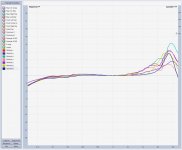
Sent from my iPhone using Tapatalk
I own an RTA-420 (same mic that was mentioned during Art's tests of the Keystone), my experience is that it is most certainly not flat down low. Measurement of a batch of the same model by a member of another forum seem to agree with that experience.

Sent from my iPhone using Tapatalk
@just a guy, just curious as to which boxes mentioned in this thread you have built or tested.
None. This isn't something that really needs to be tested. It's common sense. A bit of wood near the driver isn't going to give you better bass at tuning. It's ludicrous.
Check Ricci's measurements. He did test it, and his tests show none of the effects down near tuning that "cone correction" is supposed to provide according to the people that keep talking about it.
Do a search. At least a couple of the most respected long term members of the forum have also said it's a bunch of bunk. They are far too polite to bring it up more than once though, unfortunately.
I own an RTA-420 (same mic that was mentioned during Art's tests of the Keystone), my experience is that it is most certainly not flat down low. Measurement of a batch of the same model by a member of another forum seem to agree with that experience.
View attachment 469286
Sent from my iPhone using Tapatalk
PASC mentioned ECM8000. IIRC that mic uses the Panasonic WM61 mic capsule, which is very famous for being flat without calibration. It's usually a bit off in the khz range but down near the tuning of these subs and up to a few hundred hz it should be pretty accurate.
Anyway, your graph shows only a 1 or 1.5 db deviation from flat down to the tuning of these subs, which isn't really even worth mentioning. I'm not familiar with your mic.
A Danley TH118 TH115 is impossible to sim without taking account of the volume of the cone and baffle as a cone correction path line, as S2 would be zero!
I can't even imagine a situation where S2 would be zero. Do you have a pic or drawing?
Check Ricci's measurements. He did test it, and his tests show none of the effects down near tuning that "cone correction" is supposed to provide according to the people that keep talking about it.
Do a search. At least a couple of the most respected long term members of the forum have also said it's a bunch of bunk. They are far too polite to bring it up more than once though, unfortunately.
I don't have to search anything, I never commented on the effectiveness of cone correction. I did see someone trying to imply a number of posters (whom have actually built the cabinets in question) that they're findings are invalid. Just wanted to put proper context to the situation.
Sent from my iPhone using Tapatalk
A lot of people talk a lot about it but as far as I know only PASC and Ricci actually tried it, and no one measured anything, except Ricci, whose measurements confirm what I said. That's the proper context.
Also, PASC didn't try it in the Keystone or the TH118 either. He put it in a completely different sub, and did other mods at the same time.
Also, PASC didn't try it in the Keystone or the TH118 either. He put it in a completely different sub, and did other mods at the same time.
Last edited:
I can't even imagine a situation where S2 would be zero. Do you have a pic or drawing?
I drew it as red here. If you don't consider the cone volume, S2 goes to zero for an infinite compression ratio. Obviously that's not the case in reality. It seems to be implied that the TH118 is made in that way.
Attachments
- Status
- Not open for further replies.
- Home
- Loudspeakers
- Subwoofers
- Othorn vs XOC Th118 comparison for fun.
